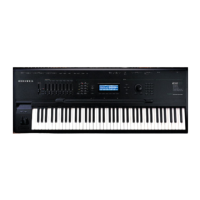page 4
Introduction
Overview of the PC3A
Pictured below is the 88-key PC3A8.
The PC3A’s 1400+ programs include improved piano sounds from the German D Grand EXP
expansion, and improved guitar, drums, synth, brass, and woodwind sounds from the KORE64
expansion. Also included are string sections from the Orchestral and Contemporary sound
blocks, Stereo Triple Strike Piano, Classic Keys for realistic vintage electric piano sounds, and
General MIDI (GM) sounds. Multi-zone performance setups are also provided; many of these
setups use note triggers to play factory-recorded songs that provide grooves and arpeggiation
that make great templates for performance or recording. An on-board sequencer with front panel
transport buttons lets you record your ideas any time inspiration strikes. This sequencer (Song
mode) lets you play back MIDI type 0 or 1 sequences, record and play back your own songs, and
record multi-timbral sequences received via MIDI.
In addition to V.A.S.T. capability, a few of the features that by themselves make the PC3A an
impressive stage and studio machine are:
• 128-voice polyphony
• Fully multi-timbral voices, so that dierent programs can be played on each MIDI channel.
• An on-board digital eects processor provides multiple simultaneous eects, including
real-time eects control, internally or via MIDI.
• More eects processing power than Kurzweil’s own KSP8 studio eects processor.
• Two additional balanced analog outputs in addition to the standard stereo audio output pair,
as well as a digital output. All of the outputs are available simultaneously.
For backup, storage, and moving les, two types of USB ports are provided on the back panel of
the PC3A. A USB storage port allows you to connect a USB device such as a thumb drive, and a
second USB Computer port lets you connect the PC3A to a computer for le transfer and MIDI
connectivity.

